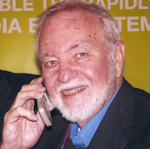In case you have not heard the news, Bluetooth, the king of short-range wireless, will get a new physical layer option soon. We normally associate Bluetooth with low-speed ad-hoc networks and cell phone headsets. Now with the decision to add ultra wideband (UWB) as a new air interface, we can expect some interesting things to happen. It is anyone's guess how this will play out in the market place, but it will certainly help the UWB silicon crowd that has been waiting for a big break like this. Here's what I think.
The Bluetooth SIG just recently announced that it had selected the multiband OFDM (M-OFDM) version of UWB for its next level of physical layer options. Recall that there were two UWB formats vying for acceptance as a standard. Since the IEEE 802.15.3a standards group could never come to a consensus on one standard, both groups went their separate ways. Most of the companies adopted the multiband OFDM version of UWB and joined together under the WiMedia Alliance to build and promote their UWB technology. Dozens of companies support this standard and lots of new silicon has become available from companies like Alereon, Staccato, WiQuest, Wisair, and others.
The other UWB faction lead by Freescale pushed their direct sequence (DS) impulse type UWB. This version is just as good as, if not better in some ways, than the OFDM version but it just never got the collective support it needed to win the standard. Freescale and others were hoping that the Bluetooth SIG would select the DS-UWB format. But it did not happen. With few wins, the DS-UWB may be a dead technology as the OFDM UWB bunch captures most of the applications. It will be interesting to see what Freescale has in mind UWB-wise. I wasn't able to speak to Martin Rofheart, Freescale's UWB boss, before this was published, but I will definitely update you after I do. Frankly, I like the DS-UWB technology since it scales better and offers lower power consumption than the more complex OFDM version, but as is often the case in electronics, the better technology does not win the marketing wars.
Honestly, I was surprised by the UWB Bluetooth. Although I support it, I had the impression that Bluetooth was going gang busters with its current PHY offerings. With its use in cell-phone handsets and headsets, Bluetooth ships more short-range transceivers than any other wireless technology including Wi-Fi. Their newer Enhanced Data Rate (EDR) version uses a different modulation scheme to get to a gross data rate of 3 Mbits/s. Since Bluetooth has stayed mainly in the audio arena, that certainly seems like an effective rate. I suspect in some high-end audio applications with surround sound or other features, Bluetooth runs out of steam even with EDR. UWB will fix that problem for sure and open the door to lots of other possibilities. The next step is for the Bluetooth SIG to define some Profiles that need the speed of UWB. Higher quality audio and video are the most likely, but there will obviously be some computer networking options and peripheral connections as well.
At the same time, the WiMedia Alliance members are all pushing for a wireless USB product. With USB 2.0 now the dominant I/O port on PCs, laptops, peripherals, and most other items, USB is a hot target with millions and millions of ports to make wireless. And UWB easily accommodates the maximum USB speed of 480 Mbits/s. While the range at that speed is only a few meters, that is sufficient. Most applications will transport data from one device to another in close proximity like a printer.
Freescale is also pursuing the USB opportunity with their product called Cable Free USB. They have a dongle that makes implementing wireless USB a snap. Their forthcoming chips support the 480-Mbits/s data rate as well.
Other potential markets for the high speed capability of UWB include a wireless IEEE1394 (Firewire) interface and the growing High Definition Multimedia Interface (HDMI) that is used in HDTV and other consumer electronics. These can be implemented in M-OFDM as well as DS-UWB.
The WiMedia bunch has won the war basically, but I suspect that Freescale's UWB will find a home nevertheless. As long as you have the same technology on both ends of the wireless link, who cares what the air interface is? Consumers don't know or care as long as it is easy to set up, cheap, and reliable. May both technologies survive and thrive.
